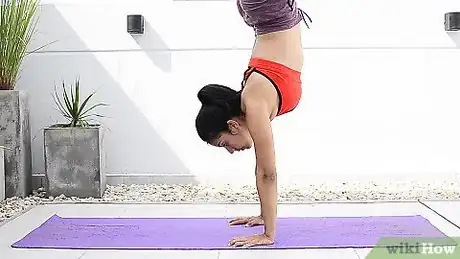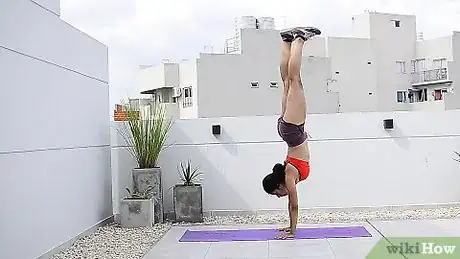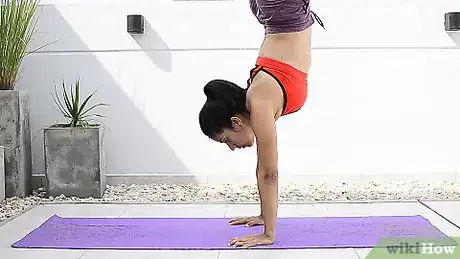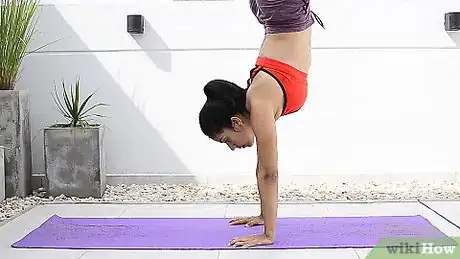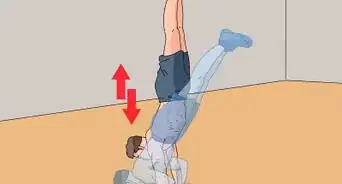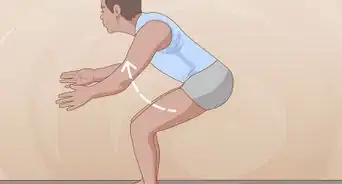This article was co-authored by Dean Theriot. Dean Theriot is a Personal Trainer and the Owner of Timberline Fitness in Houston, Texas. With over 25 years of experience in the fitness industry, Dean specializes in personal, group, and sport-specific training. Dean holds a BS in Exercise Physiology from LSU. Dean combines resistance and cardiovascular training with pilates exercises for comprehensive workouts for his clients. His sport-specific training includes football, basketball, and baseball.
wikiHow marks an article as reader-approved once it receives enough positive feedback. This article has 21 testimonials from our readers, earning it our reader-approved status.
This article has been viewed 294,958 times.
Doing a handstand requires you to have a mastery of strength, technique, and balance. Whether you’re a cheerleader, a gymnast, or a yogi, learning to do a handstand can help you get centered, learn balancing techniques, and move on toward more advanced skills, such as the front walkover or the front-handspring.
Steps
Maintaining Proper Form
-
1Get into your handstand using the proper technique. The first thing to do if you want to be able to hold your handstand is to use proper technique when you get into the handstand position. If you don’t start off with a strong foundation, it will be difficult to hold your handstand for very long.[1] Here’s what you will have to do:
- Stand up straight with your arms up over your head, as if they are glued to your ears.
- Stand with your feet shoulder width apart.
- Step forward with your dominant leg. Think of this as being halfway in the lunge position.
- Tip your body forward while keeping your back straight. Your non-dominant leg should go up first.
- Plant your hands down on the ground, shoulder width apart.
- Lift your dominant leg all the way up to meet your non-dominant leg.
- Straighten your legs and keep your back and body straight.
-
2Make sure to kick all the way up. One way to hold your handstand longer is to make sure that you kick all the way up with your non-dominant foot when you begin the handstand. Most people think that they’re kicking up all the way when they go into the handstand, when in fact, they’re only going up about 80-85% percent of the way. This is because they get scared that they’re going to fall forward. However, if you aim to kick all the way up so that your body is straight, or even so that your feet are kicked up over your body a bit, it’ll be much easier to stay straight or to adjust your body a bit than if you did not kick up enough.[2]
- Have someone film you doing a handstand or just watch you do it to tell you if you’re really kicking up as much as you can.
- You can also practice doing a handstand about a foot in front of a wall, so that the worst thing that will happen if you kick up too much is that you touch the wall with the tips of your feet. This will also give you a better sense of how far up you can really kick.
Advertisement -
3Press your fingers into the ground to maintain a strong grip on the ground. You may think that all of the power lies in your wrists, when in fact, what’s most important is that you press into your palms and the pads of your fingers to gain your strength, almost as if you’re pushing the floor away while gripping it at the same time.[3]
- If you put all the pressure in your wrists, then you’re likely to injure yourself while also making it much more difficult for yourself to stay balanced. If you put too much pressure in your wrists, then you will lose your balance and fall back on your feet.
-
4Shift your weight on your fingers and hands to stay balanced. The trick to holding a handstand isn’t staying perfectly still once you get your body up there, but in knowing how to use your body to adjust in small ways to keep your balance. One way you can hold your handstand is to counteract the way your body is moving with your hands. If your legs are falling forward, over your head, then you can press into your fingertips a bit more to help move your body back to center. If you feel yourself falling down to the standing position, then you can press a bit more into the bottom of your palms to adjust your body to be straight again.[4]
- You can also even walk on your hands slightly to counteract the direction your body is falling. If your legs are falling over your head, you can walk your hands forward slightly; if your body is falling backward, then you can move your hands back down a bit.
- If you feel your body listing to the side, move your hands over to that side. Use your hands to balance the direction of your body, and you’ll be able to hold the handstand for longer.
-
5Avoid arching your back. Another thing you want to avoid is arching your back. Not only can this cause injury, but it can lead you to fall forward, because arching your back will make your legs move over your head. Instead, focus on keeping the part of your body from your shoulders to your waist straight. You may not think you’re arching your back when you really are, so you can ask a friend or a spotter to check for you.
-
6Keep your toes pointed. Keeping your toes pointed will keep your body balanced and will keep your feet fully in line with your back and body. If your feet are flexed, it’ll be harder to control them, and they’ll be more likely to fall over your head a bit. Instead, focus on keeping nice, pointed toes from the moment you get up into the handstand until the second you come down.
-
7Squeeze your butt. Another thing you can do to hold your handstand is to squeeze the muscles in your butt, so that your butt is flexed while you do the handstand. This will keep your strength centered and will make it easier for you to maintain control over your handstand. You can practice doing this when you’re standing up, first, to get the hang of it before you go into a full-on handstand.
- If you’ve forgotten to squeeze your butt, you can do it once you’re in your handstand and feel yourself losing balance.
-
8Squeeze your legs together. Another thing you can do to hold your handstand is to make sure to squeeze your legs together. Ideally, there should be no or very little space between your legs, and they should be parallel to each other. Keeping your legs together can keep you from letting one leg fall over or fall down, leading you to lose your balance.
- However, you can also keep your balance by putting your legs into the splits — but that should be purposeful.
-
9Remember to breathe. A lot of people freeze up when they go into the handstand position, because they get nervous or want to hold their concentration. When this happens, many people forget to breathe and just let out all of their oxygen. Well, if you don’t do this, you won’t stay up there for long, and you’ll be making it much more likely for yourself to get dizzy. Make sure to take nice deep breaths, in and out, using your diaphragm, and focusing on breathing just as much as you focus on keeping your body straight.
- If you breathe purposefully, you’ll feel in control of your body, and you’ll feel like holding a handstand is much more manageable. In yoga, for example, purposeful breathing is the key to any pose, especially the handstand.
-
10Keep your arms locked by your ears. You should check to make sure that your arms are locked by your ears. If they’re too far apart, not parallel, or even too far above or below your ears, then it’ll be hard to hold your handstand for very long. The next time you do a handstand, check to make sure that your hands have the proper form. This can help you maintain your handstand for longer.
-
11Keep your shoulders over your hands. Another thing you should do if you want to hold your handstand is to make sure that you’ve kept your shoulders over your hands. Having your shoulders over your hands can help you maintain your balance, and ensure that your body is pretty much in a straight line, from your arms all the way down to your legs. Most people tend to place their hands a little bit above their shoulders when they do a handstand, so you should be vigilant about keeping them in line.
-
12Do a split to stay balanced. Some people think it’s harder to stay up if they keep their legs together and instead prefer to put their legs in the split position in order to maintain their balance. If you have one leg over your head and one leg behind it, it can be easier for you to shift your balance by moving one leg slightly down or the other leg slightly up to keep your body even. Sometimes holding a handstand with both feet together can be a bit of a challenge because both of your legs feel “stuck” together, and they tend to fall or stay up as a unit, which can make it harder to control your balance.[5]
Improving Your Strength and Balance
-
1Practice doing your handstand against a wall. Another thing you can do to practice holding your handstand is to do it against a wall. Leave about half a foot to a foot of space between you and the wall, and kick fully up into your handstand, so that you know you have some support if you fall over. If your legs fall forward too much and touch the wall, just gently push them away from it again.[6]
- This can help you gain confidence in holding your handstand and can show you that nothing bad will happen if you fall out of it.
- Practicing against a wall can also be more efficient because you don’t have to start from scratch every time you fall over; if your feet touch the wall, you can just lightly kick them back up over your head instead of falling down.
-
2Try doing a vertical caterpillar. Crouch down next to a wall, facing away from the wall. Walk your hands forwards as far as you can reach. walk your feet up the wall as high as they can go. Walk your hands up closer to the wall. Walk your feet up again. Hold this for as long as you can. It will improve your arm strength and your abs.
-
3Practice basic skills on a balance beam. If you’re a gymnast, then you should already be familiar with the balance beam. You don’t have to practice a handstand on the balance beam to improve your balance. In fact, just walking on the balance beam, standing on one leg at a time, pivoting, or even doing a cartwheel on it, or a round-off off of it, can get you more in touch with your balance, and can help you see how to move your body to stabilize your position.
- Just spending an hour a week on a balance beam can really work wonders on your balance, whether you’re a gymnast or not. If you’re not a gymnast, then you can practice balancing on a narrow surface, such as a concrete bench, as long as you have enough room to move safely.
-
4Build up your arm strength. You may have a hard time holding a handstand simply because you lack arm strength. Your biceps, triceps, and forearms are crucial for holding up your body weight and helping you maintain a strong handstand. If you want to build up your arm strength, you can try a number of exercises in order to make them strong. Here are a few exercises you can try:
- Perform dumbbell overhead presses to improve your arm strength.
- Holding a handstand against a wall for 10 seconds, for 5 repetitions at a time.
- Holding a handstand against a wall and doing shoulder touches. Hold your handstand, and then lift up one arm quickly and touch the shoulder on the same side of your body with it. Then, repeat this with your other hand. Do this about 10 times on each side for 2 repetitions.
- The plank position. The plank position is a yoga pose and is the starting position for the push-up. Get on the ground and push up through your palms, so that your back and legs remain straight, and hold the position for at least 10 seconds. Repeat this 3 times or transition into doing 2 sets of 5 push-ups.
-
5Build up your core strength. Your core, or your abs, is essential to holding a handstand, as well as maintaining any balancing pose. If you want to be able to hold a handstand, you can work on strengthening your core so you have a more solid foundation to work with. You can work on doing a daily arm and core workout to get stronger for your handstands. Here are some exercises you can try to build up your core:
- The basic sit-up. Simply lie on your back, raise your knees, cross your arms over your chest, and reach up toward your knees, and then back down to your back. Do 2 sets of 20.
- The banana. For this exercise, you can lie on your back, lifting your hands up over your head and raising them a few inches off the ground while doing the same with your feet, until your body is in a “banana” shape. Hold this position for 10 seconds and repeat this exercise once.
- The bicycle. Get on the floor with your hands behind your head and neck, and “cycle” your legs up in the air. Raise your elbow to the opposite knee as it moves toward your head, and repeat with the other elbow. Do the bicycle for 30 seconds at a time.
Expert Q&A
-
QuestionAre handstands dangerous?
 Rosalind LutskyRosalind Lutsky worked as a gymnastics coach at SB Gymnastics at Stanford University, coaching children from ages 5-12 years old during her time as a Stanford student. She was a competitive gymnast growing up, and competed for her local gymnastics team in Minnesota.
Rosalind LutskyRosalind Lutsky worked as a gymnastics coach at SB Gymnastics at Stanford University, coaching children from ages 5-12 years old during her time as a Stanford student. She was a competitive gymnast growing up, and competed for her local gymnastics team in Minnesota.
Former Gymnastics Coach They can be. Good form is more important than doing the handstand unassisted. It can be really helpful to practice your handstand up against a wall to get the form down. Or, have a spotter support some of your weight and hold your legs together as you’re learning the skill.
They can be. Good form is more important than doing the handstand unassisted. It can be really helpful to practice your handstand up against a wall to get the form down. Or, have a spotter support some of your weight and hold your legs together as you’re learning the skill. -
QuestionHow can I perfect my backbend kickover?
 Community AnswerFirst you should make sure your backbend is perfected. Once you have the backbend down, try doing a backbend facing a wall. Once you're in the backbend position, use the wall to push your feet off to complete your kickover. Keep practicing this way until you no longer need the wall.
Community AnswerFirst you should make sure your backbend is perfected. Once you have the backbend down, try doing a backbend facing a wall. Once you're in the backbend position, use the wall to push your feet off to complete your kickover. Keep practicing this way until you no longer need the wall. -
QuestionEvery time I do a flip, I land on my bum. How do I land on my feet?
 Community AnswerBring your legs closer to your body. That way, you may fall, but your legs will be there to break the fall.
Community AnswerBring your legs closer to your body. That way, you may fall, but your legs will be there to break the fall.
Warnings
- Do not do a handstand against a wall with pictures or hangings on it.⧼thumbs_response⧽
- If it starts to hurt stop rolling out.⧼thumbs_response⧽
- When doing handstands have a 2 meter (6.6 ft) boundary around to protect you and other people.⧼thumbs_response⧽
- Make sure there is space around you so you and other people won't get hit. If they get hit, they can get hurt very badly.⧼thumbs_response⧽
- Make sure there are no cabinets, fragile things, etc. in the way of you if you go over.⧼thumbs_response⧽
- When rolling out be careful of neck and back.[7]⧼thumbs_response⧽
References
- ↑ https://www.youtube.com/watch?v=ZH3PkhtOUwg
- ↑ https://breakingmuscle.com/fitness/how-to-hold-a-freestanding-handstand
- ↑ https://breakingmuscle.com/fitness/how-to-hold-a-freestanding-handstand
- ↑ https://www.youtube.com/watch?v=ZH3PkhtOUwg
- ↑ https://yogainternational.com/article/view/3-tips-for-finding-your-balance-in-handstand
- ↑ https://www.youtube.com/watch?v=8z5Rgyr-d0g
- ↑ https://www.youtube.com/watch?v=ZzEP7XvkDDk
About This Article
To hold your handstand longer, make sure you kick all the way up with your non-dominant foot, so that your body is straight, not bent. You should also squeeze your legs and glutes to create stability. To make sure your base is as stable as possible, keep your shoulders over your hands and locked tight by your ears. If you need to keep your balance, try shifting your weight through your fingers and palms, or walk forward and back on your hands to counteract your swaying. To pinpoint what exactly you can do to improve your form, try filming yourself. If you want to learn more from our Gymnastics Coach co-author, like exercises to try to improve your strength and balance, keep reading!

